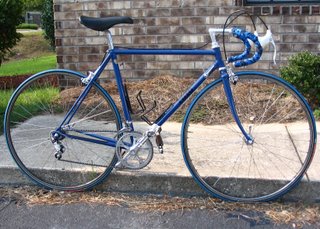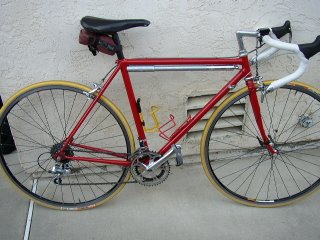What does the length of your forearm and the price of fish have to do with stem length?
 Fri, July 21, 2006
Fri, July 21, 2006 
This method of determining handlebar stem length has been around for ever. My cycling experience dates back over 55 years and it was practiced then; actually it is not a bad guide and works for most people. Place your elbow against the nose of your saddle and if your finger tips do not fit behind the handle bars as shown above, then your stem is probably too short. If the bars are more than 2cm. away from the finger tips your stem maybe too long.
When I was racing I used a stem that placed my finger tips one centimeter from the bars; now as a mild concession to my aging body I’m using a stem a centimeter shorter. If you are wondering as I did for many years what the length of a persons forearm has to do with stem length? I will explain.
When I am determining frame size I take into account three body measurements:
1. Inside leg length (Often referred to as inseam.) measured crotch to floor without shoes.
2. Overall height.
3. Shoe size. (Length of foot.)
I do not require body length because I have overall height minus inseam. I do not require arm length because this is relevant to leg length and foot length combined.
Human bodies although all different do generally follow certain rules of nature. We have the same basic design and structure as most other animals on this planet except we walk on our hind legs while most others walk on all four. So it follows a person with long legs will also have long arms; short legs, short arms.
Four legged animals generally walk on their toes (and finger tips) whereas we stand and walk on our heels. So some people have a long body, but short legs and it is not unusual for a person with this build to have longer feet, and also longer arms. The long arms are not out of proportion if you consider the leg length is a combination of inseam plus the length of foot.
When pedaling a bicycle the toe is pointing downward at the bottom of the pedal stroke so the foot becomes an extension of the leg; which is why it has to be taken into consideration when determining frame size. The person with short legs, long feet needs a larger frame than their inseam alone would suggest. The larger frame with its proportionally longer top tube will also accommodate this rider’s longer body and arms
The length of the forearm is proportionate in length to the length of the foot; take one of your shoes and hold it against your forearm and you will see it is the same length as the distance from your elbow to your wrist. In other words the big bones in your forearm are the same length as your foot.
So assuming you are on the right size frame and your seat is set at the correct height; then chances are if you have very long feet then you will have a short inseam and a long body.
Because you have long feet you also have a long forearm and if you do this little elbow against the saddle trick it will show you need a long handlebar stem which will be right for your long body and arms.
A person with very long legs for their height will also have long arms but will have a short body and small feet relative to their height. Small feet mean short forearm and a shorter stem which will be right for their short body. Because this rider has long legs his saddle will be set high making a greater distance from the seat to the bars; this will accommodate his long arms.
There is another method for determining stem length which states: “A rider seated with their hands on the drops of the bars, will have the front hub obscured from view by the handlebars.”
This works in the same way; longer body calls for a longer stem and vice-versa. The only thing is that this method could be affected by the head angle of the frame and the length of fork rake. I prefer the length of forearm method because it is simpler. It works for most people but there is a small percentage that it will not. I always say if you are comfortable and happy with your current position, don’t change it. Go by the old “If it ain’t broke” adage.
And what does this all have to do with the price of fish? Nothing at all, but it got your attention.
 Dave Moulton | Comments Off |
Dave Moulton | Comments Off |  Bike Fit
Bike Fit 




















